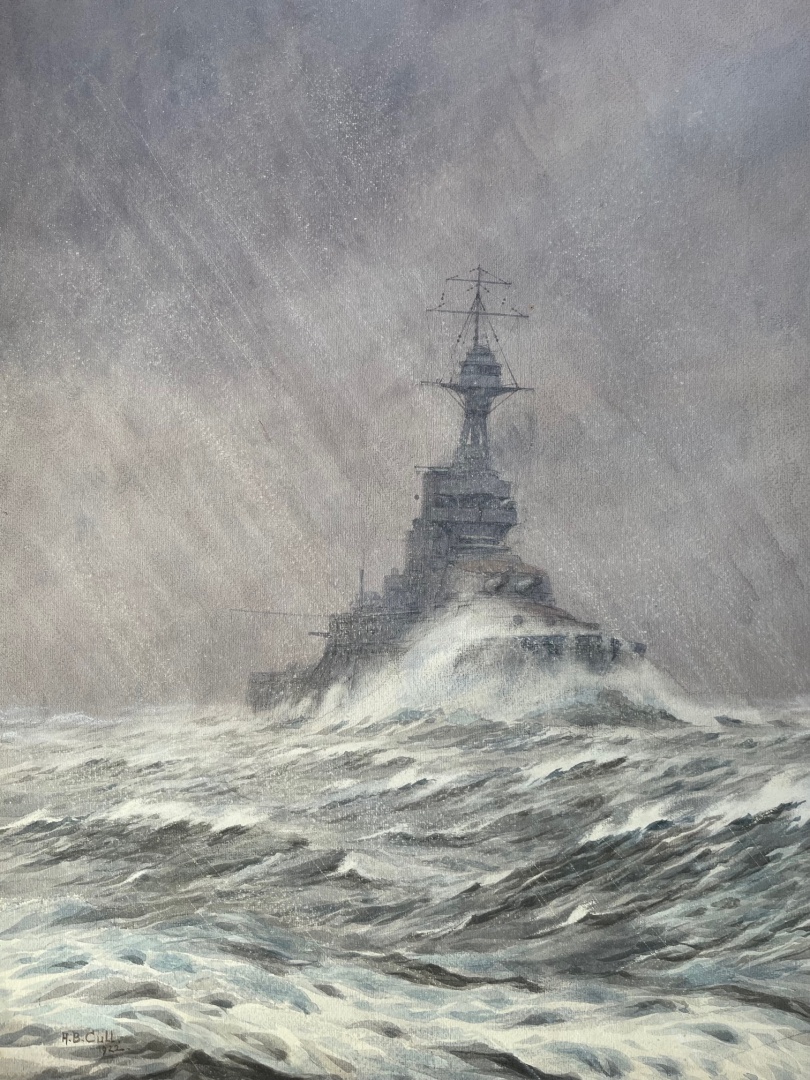HMS CENTURION in dirty weather
. Watercolour signed and dated (LL) AB Cull 1923.
28.5 x 21 inches (72.39 x 53.34 cms)
upon application
This original has been sold and is no longer available.
The type of scene so beloved by Cull - a patrol weary dreadnought breasting her way through a big sea on a filthy cold day. There is a full gale blowing and intermittent sleet squalls add to the misery for those who must be on the upper deck or bridge. He has used his favoured Whatman's Sketching Board, Rough Surface, manufactured by Winsor & Newton Ltd.
CENTURION was one of four King George V Class battleships, KING GEORGE V, AJAX, AUDACIOUS and CENTURION herself. A follow-on batch of the Orion Class they were slightly longer (at 597 feet overall), beamier and faster at about 21 knots. They had a pleasingly well balanced profile though apparently were fairly wet in anything of a sea. The fleet was hoping that the 4 inch secondary armament of the earlier Orions would be replaced by something more substantial but the Treasury had decided otherwise! The main armament was ten 12.5 ins guns mounted in five turrets; the secondary armament being sixteen 4 inchers. CENTURION's war service was pretty typical of so much of the Grand Fleet's endless patrolling in the North Sea willing the German High Seas Fleet to come out. Helter skelter, short noice sailing and excitement when it looked as if it was going to; a few skirmishes if you were lucky and then, of course, the end of May 1916 when mayhem errupted at Jutland for 36 hours. Then back to endless patrolling again - and from September to March each year it was very often in vile weather like this that Cull has painted that took its toll on men and machinery. Back in the main fleet anchorage of Scapa brought little rest either as so often the days and nights were spent trying to hang onto anchors as gale after gale swept through. Boilers had to remain flashed up, anchor and bridge watches closed up and there was little rest to be had for many.
Judging from the arrangement of searchlight towers around the after funnel and the configuration of the main spotting top this was CENTURION in the period 1917 -1919 when Captain Roger Keyes CB CMG DSO MVO was in command. After he had left the battleship he went on to plan and then lead the famous raid on Zeebrugge. He was Commander-in Chief of the Mediterranean Fleet in the 1930s and did his best to rejoin the navy - long after he had retired from active service - come the Second World War. Churchill found his endless "arm chair suggestions" warying, but useful work was eventually found for this fervently patriotic but long out of date Admiral of the Fleet!
